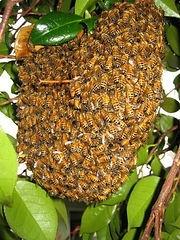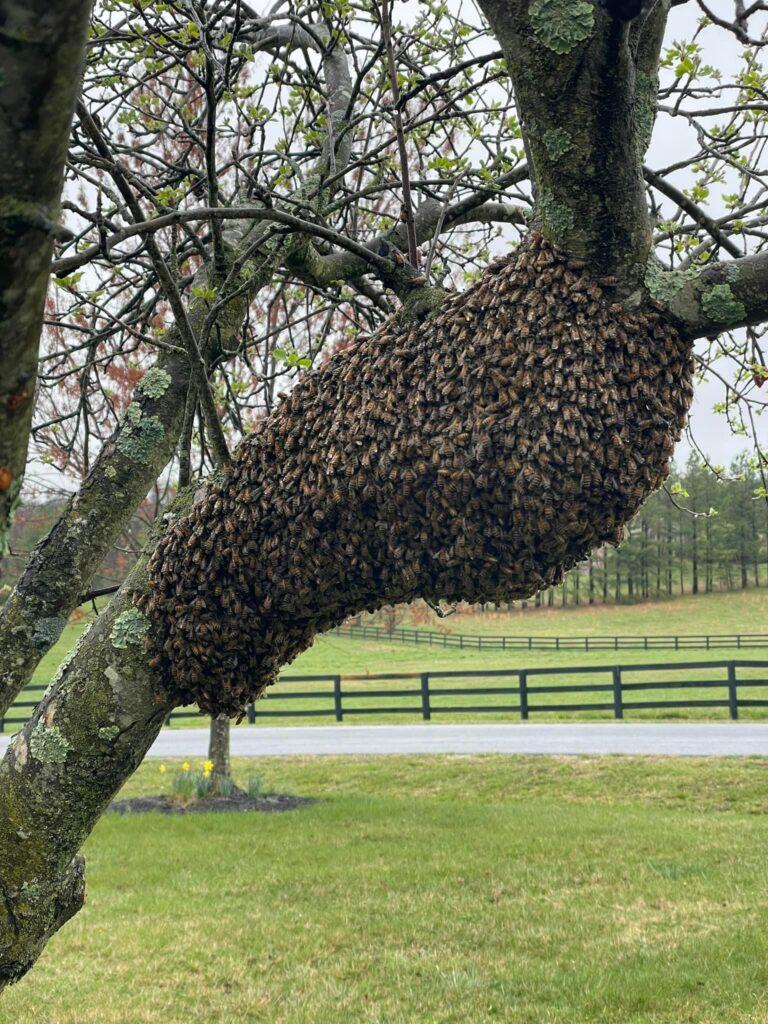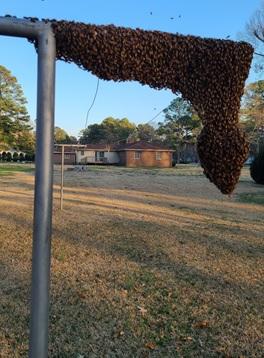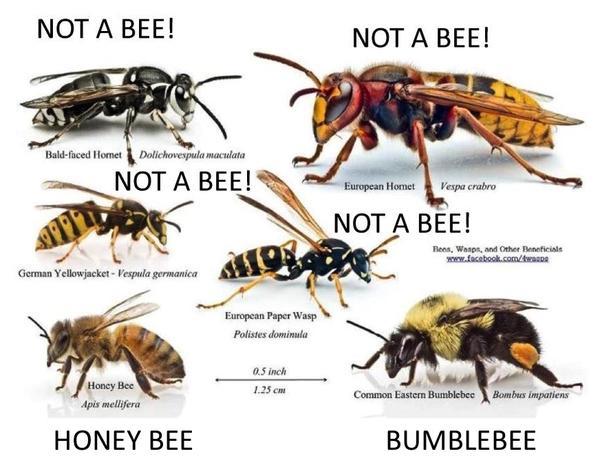Swarm Assistance
IF YOU HAVE A SWARM…..DO NOT SPRAY IT!!!…CALL ONE OF US
Are they Honeybees? Yes, these pictures are Honeybee Swarms.




Additional Information on Bee Swarms
The Beekeepers of the Northern Shenandoah (BONS) compiles a list each year of members who provide Honey Bee swarm and hive removal help or service. The expectation is that you will be provided with prompt, helpful and courteous service with your cooperation in the removal. Most of the beekeepers have a passion for beekeeping and want the bees to survive.
We ask that you review the pictures to determine if you have Honey Bees. Typically, swarms occur in April, May and June in this area. The swarm is the honeybee colony reproducing itself. An undetermined percentage of the bees and the old queen leave to swarm. A good swarm will be about 5,000-20,000 bees. If the air is filled with a cloud of flying bees, it is a swarm. A swarm will usually settle on a tree branch or bush, lost bees will join it. It builds up to about a football shaped size, depending on honeybee numbers and surrounding geometry. It is waiting, sending out bees to “scout out” a permanent home.
If you have a SWARM, (large mass of honeybees) hanging from a tree, bush or side of a building, in your yard or on your property please refer to our swarm list below. We have experienced beekeepers you can call to rescue the swarm. Swarms are normally very docile and are simply looking for a new open cavity to colonize. You should call a beekeeper as soon as possible. This way we can remove them before they “scout out” a permanent location in someone’s house, garage, etc.
Please call us BEFORE spraying honey bees with anything, even a garden hose. Doing this could destroy the queen and make swarm removal more difficult. Swarms without queens are of little value to the beekeeper and nearly always perish.
Don’t be fooled by ground nesting hornets or miner bees commonly known as yellow jackets, see the pictures. These are not honeybees! They commonly attend outdoor functions like picnics for food and a source of sugars. They also build nests inside man-made structures. Call your local exterminator or Google “how to get rid of Yellow Jackets”
BEES IN WALLS/FLOORS (Cutouts) or Hollow Trees:
If you have an established colony of honeybees in your house, some other structure or a hollow of a tree we do not have anyone who can help you.
Most pest control companies will not kill honeybees but will treat other bees and wasps. Many people get these two VERY different insects mixed up (see above for pictures) Some people manage to live happily with honeybees in their walls for years.
We get many calls for “honeybees living in the ground”. Honeybees never, ever live in the ground, they live mainly in trees, under your eaves, even in your walls or attic. Honey bees are fuzzy and actually more orange or gold in color, wasps are not fuzzy and yellow. These wasps can sting repeatedly, they will come out of the ground if you are mowing or walk over the hive, it takes very little to provoke them, and that is what makes them dangerous. A honeybee will almost never sting unless provoked or protecting the hive.
Welcome to BONS Swarm Identification!
Take a quiz to learn if the insect you've seen might be a honey bee. If it is, we'll provide you with contact information for expert swarm handlers!
Swarm Chasers
| Name | Phone | Service Area |
|---|---|---|
| Doug Koch | 540-313-5183 | Winchester City, Frederick Co. |
| Chris Venable | 540-974-2280 | Winchester, Frederick, Northern Shenandoah, Western Clarke |
| Paul Norwood | 703-381-7014 | Cut-Outs, Clarke, Frederick, Loudoun, Berkely (WV), Jefferson (WV) |
| Denise Vowell | 540-636-7531 | Warren County |
| Travis Siever | 540-550-7907 | Warren County |
| Ed Shideler | 540-272-6265 | Winchester, Fred. Co, Western Clark Co. |
| David Reese | 540-636-8669 | Warren County |
| Linda Cunningham | 540-550-5587 | Winchester, Fred Co, Clarke Co. |
| Rick Cosman | 703-597-4076 | Warren, Frederick, Shenandoah Co. |
| Steve Heise | 301-466-8040 | Warren Co + Southern Clarke Co. |
| Dan Stange | 540-247-4378 | Warren Co, Northern Shenandoah, Southern Frederick and Clarke Co. |
| Jen Hoyt | 540-550-0696 | Warren Co, Frederick Co, Shenandoah Co. |
| Jerrold Pike | 540-539-0980 | Winchester City, Frederick Co. |
| Mike/Donielle Rininger | 540-317-1170 | Northern Fauquier Co |
| Tim Riggleman | 540-336-3697 | Winchester, Frederick, Clarke Co. |
| Joanne LeClair | 540-660-4550 | Clarke Co, Frederick Co |
| Suzette Niess | 703-732-2638 | Winchester, Frederick Co |
| Steve Sabol | 540-398-7285 | Winchester, Frederick Co |
| Danny Smedley | 540-522-4994 | Warren, Clarke, Fauquier, Rappahannock |
